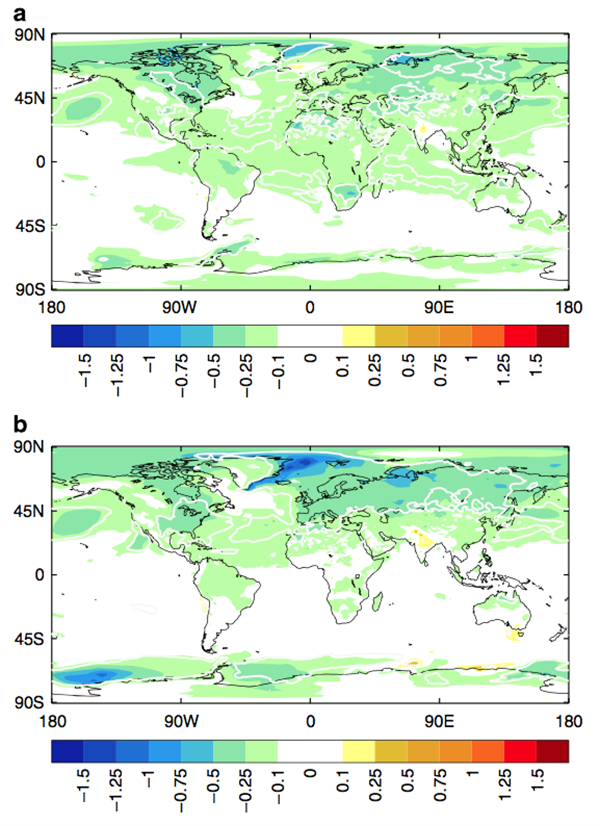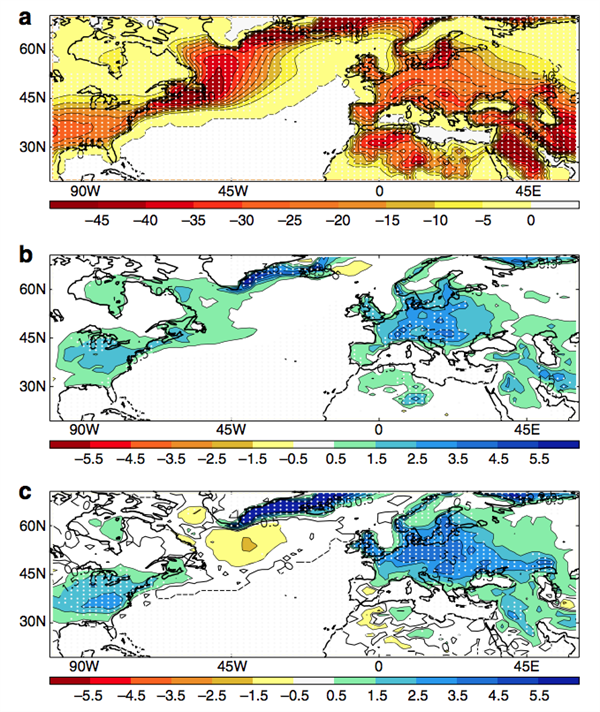Robert McSweeney
23.06.2015 | 4:00pmOver the past few decades, our Sun has been relatively active, giving off high levels of the solar radiation that warms the Earth. However, in recent years this peak activity has tailed off, prompting scientists to wonder if the Sun is heading into a period of lower output.
A new study says even if the Sun’s activity did drop off for a while, it wouldn’t have much impact on rising global temperatures. But it could mean a higher chance of a chilly winter in Europe and the US, the researchers say.
Solar output
The Sun’s activity rises and falls on an approximately 11-year cycle, but it can experience longer variations from one century to another. Over the past 10,000 years, the Sun has hit around 30 periods of very high or very low activity – called ‘grand maxima’ and ‘grand minima’.
One of these occurred between 1645 and 1715, when the Sun went through a prolonged spell of low solar activity, known as the Maunder Minimum. This didn’t have much of an effect on global climate, but it was linked to a number of very cold winters in Europe.
In 2010, scientists predicted an 8% chance that we could return to Maunder Minimum conditions within the next 40 years.
But since that study was published, solar activity has declined further, and this likelihood has increased to 15 or 20%, says new research published today in open-access journal Nature Communications.
In fact, the Sun’s output has declined faster than any time in our 9,300-year record, say the researchers. And so they set out to analyse what this could mean for global and regional climate.
Small decrease
The researchers used a climate model to run two scenarios where solar activity declines to a grand minimum. They then compared the results with a control scenario where the Sun continues on its regular cycle.
For all model runs they used the RCP8.5 scenario to account for future climate change – this is the scenario with the highest greenhouse gas emissions of those used by the Intergovernmental Panel on Climate Change ( IPCC). Global emissions are currently tracking just above this scenario.
You can see the modelling results in the maps below. Overall, a grand solar minimum could see global average temperature rise trimmed by around 0.12C for the second half of this century, the researchers say. Larger changes (shown as dark greens and blues) are seen in some parts of the northern hemisphere.
Projected difference in annual average surface temperature for 2050-99 between RCP8.5 emissions scenario and a) Solar scenario 1 and b) Solar scenario 2. Areas of blue and green show regions projected to be cooler because of the solar minimum. Source: Ineson, S. et al. (2015)
This wouldn’t make much of a dent in global temperature increases that could well exceed four degrees by the end of the century under RCP8.5, says lead author Sarah Ineson, a climate scientist at the UK Met Office.
These results are in keeping with similar studies, she tells Carbon Brief:
“The expected decrease in global mean surface temperature due to a fall in solar irradiation would be small in comparison to the projected anthropogenic warming.”
Under the RCP8.5 scenario, the solar minimum would delay warming for only a couple of years, the paper says. This counters the claim that occasionally appears in some sections of the media that a solar minimum could see the Earth head into an ice age.
Northern hemisphere chill
While the impacts of a solar minimum are small on a global scale, they can be larger for specific regions, the paper finds.
How much of the Sun’s radiation hits the Earth can affect the circulation patterns over the Atlantic Ocean, Ineson says. This can make natural fluctuations, such as the North Atlantic Oscillation (NAO) and Arctic Oscillation (AO), more negative, which can affect the winters here in the northern hemisphere, she says:
“A more negative Arctic Oscillation or North Atlantic Oscillation is associated with reduced westerly winds over the North Atlantic sector and a southward shift in the mid-latitude storm track which causes reduced temperatures in the US and northern Europe.”
You can see in the top map of the figure below that climate change is likely to cause a large decrease in frost days across the northern hemisphere winter. But as the second and third maps show, a solar minimum could add another five days of frost per year in much of Europe and the US.
Change in average number of frost days. Maps show difference in winter (December-February) frost days between a) RCP8.5 model run (2050-99) and historical period (1971-2000), b) Solar minimum Scenario 1 and RCP8.5, and c) Solar minimum Scenario 2 and RCP8.5. Source: Ineson, S. et al. (2015)
For Europe, specifically, the study finds the solar minimum could knock 0.4-0.8C off a projected winter temperature rise of 6.6C, under RCP8.5 and relative to 1971-2000.
Shifting of the storm track across the Atlantic Ocean would also mean less rainfall coming to northern Europe in winter, the study says, slightly reducing the increases projected under climate change.
Temporary effect
With only small impacts on global climate, the study shows that a drop in the Sun’s strength shouldn’t delay action on climate change, says Prof Joanna Haigh, co-director of the Grantham Institute for Climate Change at Imperial College London, who wasn’t involved in the study. She tells Carbon Brief:
“No one should consider the results to provide justification for bothering less about carbon dioxide emissions.”
And any impact of a solar minimum on climate would be short-lived, says Haigh, until such time that the Sun’s activity increased again.
Prof Jerry Meehl, from the National Centre for Atmospheric Science (NCAR) in Boulder, Colorado, who also wasn’t involved, agrees. He tells Carbon Brief that his recent study shows the rebound effect on temperatures is important:
“When the grand solar minimum ends, the climate system warms back up to the levels it would have been if there had never been a grand solar minimum. Thus the effects would be temporary.”
So it seems that a dip in the Sun’s activity would only have a limited impact on global climate, and wouldn’t call a halt to human-caused climate change.
Main image: Low sun over the British countryside in the winter.
Ineson, S. et al. (2015) Regional climate impacts of a possible future grand solar minimum. Nature Communications, doi:10.1038/ncomms8535
-
Solar minimum could bring cold winters to Europe and US, but would not hold off climate change


